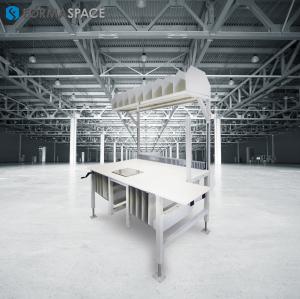13 Ways Packing Stations Have Advanced
Countdown the top 13 ways that Packaging Stations have changed for the better.
Ready to up your game in the overnight delivery world? Take a look at Formaspace Packing and Shipping Station solutions.
AUSTIN, TEXAS, UNITED STATES, October 24, 2016 /EINPresswire.com/ -- As consumers have increasingly come to rely on overnight delivery, there is an enhanced pressure on supply chain management teams to get their distribution centers in line with a semblance of urgency. Packing Stations are a potential bottleneck in the process, so more and more attention is being paid to improving their material handling efficiency.— Formaspace
This week, we countdown the top 13 ways that Packaging Stations have changed for the better.
Let’s begin our countdown, starting with number 13: Customized Packing Stations Designed for Different Tasks.
#13 Customized Packing Stations Designed for Different Tasks
Where packing stations used to be fairly uniform from distribution center to distribution center, specialization is the new byword in packing station design. Heavy or bulky items are now often segregated from smaller, light items. In contrast, bulky items are sent to packing stations with large tables built for heavier SKUs. Meanwhile, shippers working with smaller, lighter items can work more rapidly — by taking fewer steps — at compact packing stations designed to fit smaller, high-volume shipping boxes.
#12 Automatic Height Adjustment for Different Stature Operators
Lower back pain, shoulder pain, repetitive stress injuries — these are all examples of the types of on-the-job injuries we strive to avoid in distribution centers. Fortunately, just as packing stations are become customized for individual tasks, it’s become more and more common for packing stations to be customized on the fly for individual operators.
Height-adjustable work surfaces are becoming one of the most requested features here at Formaspace. How do they work? Easy to access controls are installed that can adjust the height of work surfaces at the touch of a button. Our motorized furniture solutions, using hydraulic power, allow your employees to choose the right height to match their physical stature, reducing the potential for injuries. You owe it to your employees to try it out.
...
#7 Visual and Auditory Cues for Picking Operators
Many of the WMS / WCS solution providers have introduced specialized tools to help operators pick and put inventory. These advances are broken down into a few categories:
Barcode systems with a hand held wand or sensors:
These devices were among the first tools available.
They allow verification of picking and packing.
RFID Tags
Infrared Tags allow close range tracking of inventory and can be used in tandem with visual and auditory cues.
Visual Cues: Pick to Light, Put to Light
Complex warehouse solutions use a variety of light systems (often LED lamps) to guide pickers and packers to inventory bins to pick SKUs.
Auditory Cues: Voice Activation
More recently, the synthetic computer voices provider operators wearing headsets with verbal commands for picking and packing inventory
Heads Up Displays:
On the horizon are Google Glass-style heads up displays to help operators find and confirm inventory SKUs for picking and packing.
#6 Evolution of Batching Techniques in Supply Chain Management
The introduction of different batching techniques has had a big effect on the productivity of distribution center picking and packing throughput.
The simplest technique, known as Discrete Picking, came onto the scene first. This technique is very basic: one customer order, one picking operator, one packing operator. This Discrete Picking approach makes sense intuitively: for each customer order, there is one picker who traverses the warehouse to collect the order items. Once everything is collated, it’s sent to the packer. Each item is handled a minimum number of times.
But in most high-volume cases, the Discrete Picking process is far from the fastest method. Experience has shown that running parallel operations in batches with more than one picker can move inventory through the distribution center much faster than relying on one order/one picker alone.
These parallel batch picking processes are broken down into many different sub-categories. Some of the main approaches include:
Zone Picking (and a variation known as ‘Pick and Pass’):
Pickers cover a geographic zone within the warehouse, which are combined with picks from other zones to complete an order.
Batch Picking:
Pickers pick the same SKU to fulfill multiple orders, then moves to next SKU.
Cluster Picking
Pickers pick multiple items into multiple container bins, totes or shippers (e.g. shipping boxes).
Read more... https://formaspace.com/articles/material-handling/13-ways-packing-stations-have-advanced/?utm_source=einpresswire&utm_medium=content&utm_campaign=article-053116
Mehmet Atesoglu
Formaspace
8002511505
email us here

